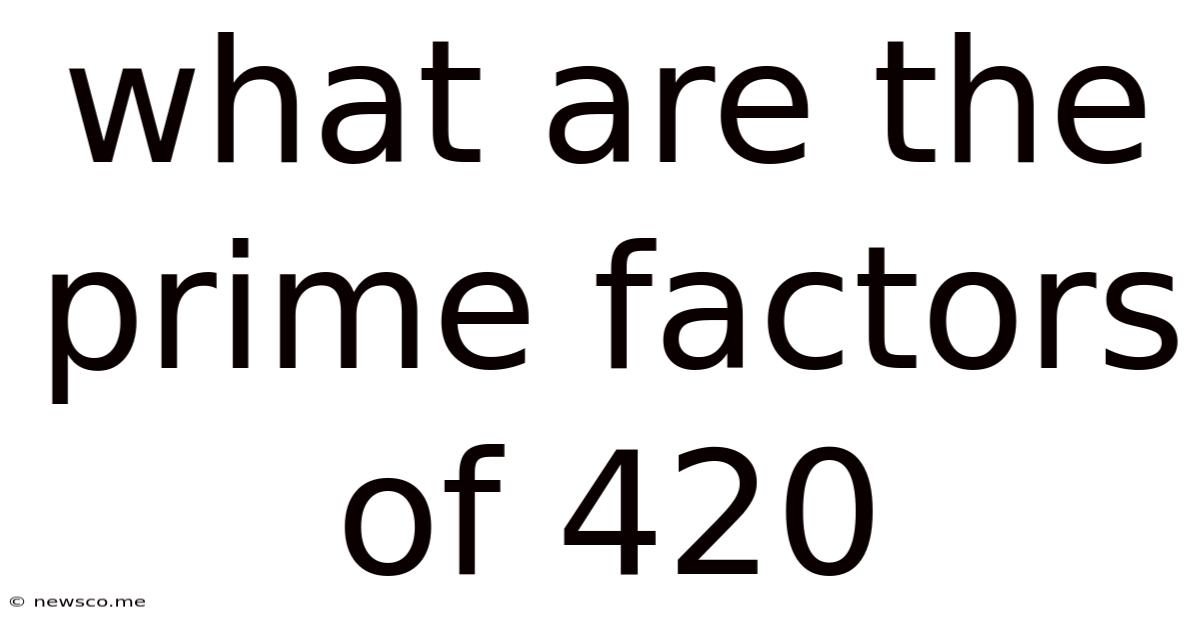What Are The Prime Factors Of 420
News Co
May 08, 2025 · 4 min read

Table of Contents
What Are the Prime Factors of 420? A Deep Dive into Prime Factorization
Finding the prime factors of a number might seem like a simple mathematical exercise, but it's a fundamental concept with far-reaching applications in various fields, from cryptography to computer science. Let's delve into the fascinating world of prime factorization, using 420 as our illustrative example. This comprehensive guide will not only reveal the prime factors of 420 but also explain the underlying principles and techniques involved, exploring various methods and their practical implications.
Understanding Prime Numbers and Prime Factorization
Before we tackle 420, let's establish a solid foundation. A prime number is a whole number greater than 1 that has only two divisors: 1 and itself. Examples include 2, 3, 5, 7, 11, and so on. Prime numbers are the building blocks of all other whole numbers.
Prime factorization is the process of expressing a composite number (a number that is not prime) as a product of its prime factors. This representation is unique for every composite number, meaning there's only one way to express it as a product of primes (ignoring the order of the factors). This uniqueness is crucial in various mathematical applications.
Method 1: The Factor Tree Method – A Visual Approach
The factor tree method is a visually intuitive way to find the prime factors. We start by breaking down the number into any two factors, and we continue this process until all the factors are prime.
Let's apply this to 420:
- Start with 420: We can begin by factoring 420 into 2 and 210.
- Break down 210: 210 can be factored into 2 and 105.
- Further breakdown: 105 factors into 3 and 35.
- Almost there: 35 factors into 5 and 7.
Now, all our factors are prime numbers. Our factor tree looks something like this:
420
/ \
2 210
/ \
2 105
/ \
3 35
/ \
5 7
Therefore, the prime factorization of 420 is 2 x 2 x 3 x 5 x 7, or 2² x 3 x 5 x 7.
Method 2: Repeated Division – A Systematic Approach
The repeated division method involves systematically dividing the number by the smallest prime number possible until you reach 1. This method is particularly efficient for larger numbers.
Let's use this method for 420:
- Divide by 2: 420 / 2 = 210
- Divide by 2 again: 210 / 2 = 105
- Divide by 3: 105 / 3 = 35
- Divide by 5: 35 / 5 = 7
- Divide by 7: 7 / 7 = 1
We've reached 1, meaning we've found all the prime factors. The prime factors are the divisors used in each step: 2, 2, 3, 5, and 7. Again, the prime factorization of 420 is 2² x 3 x 5 x 7.
The Significance of Prime Factorization
The seemingly simple act of finding prime factors has profound implications across numerous fields:
1. Cryptography:
Prime factorization is the cornerstone of many modern encryption algorithms. The difficulty of factoring very large numbers into their prime components is the foundation of the RSA algorithm, widely used to secure online transactions and communications.
2. Number Theory:
Prime factorization is central to many theorems and conjectures in number theory, a branch of mathematics focused on the properties of numbers. Understanding prime factorization helps us understand the structure and behavior of numbers in profound ways.
3. Computer Science:
Algorithms for prime factorization are crucial in computer science, influencing areas like data compression, hashing, and random number generation. The efficiency of these algorithms has significant implications for the performance of various computer systems.
4. Mathematics Education:
Understanding prime factorization develops critical thinking skills, problem-solving abilities, and a deeper appreciation for the fundamental building blocks of mathematics.
Exploring Further: Advanced Techniques and Challenges
While the factor tree and repeated division methods are sufficient for smaller numbers like 420, larger numbers require more sophisticated techniques. These include:
- Trial Division: Systematically testing divisibility by prime numbers up to the square root of the number.
- Pollard's Rho Algorithm: A probabilistic algorithm that is efficient for finding small prime factors.
- General Number Field Sieve (GNFS): The most efficient known algorithm for factoring very large numbers. This algorithm is used to break some cryptographic systems.
These advanced methods highlight the ongoing research and development in the field of prime factorization, driving advancements in cryptography and computer science. The challenge of factoring increasingly large numbers continues to be a major focus of research.
Conclusion: The Prime Factorization of 420 and Beyond
We've successfully determined that the prime factorization of 420 is 2² x 3 x 5 x 7. This seemingly simple calculation underscores the fundamental importance of prime numbers and their factorization in mathematics and its applications. Understanding prime factorization not only provides a deeper insight into the structure of numbers but also underpins crucial technologies that shape our digital world. From the seemingly straightforward methods like the factor tree to the sophisticated algorithms used to factor massive numbers, the exploration of prime factorization remains a fascinating and continually evolving field of study. By grasping the principles and techniques outlined here, you've taken a significant step towards appreciating the power and elegance of prime numbers and their factorization.
Latest Posts
Related Post
Thank you for visiting our website which covers about What Are The Prime Factors Of 420 . We hope the information provided has been useful to you. Feel free to contact us if you have any questions or need further assistance. See you next time and don't miss to bookmark.